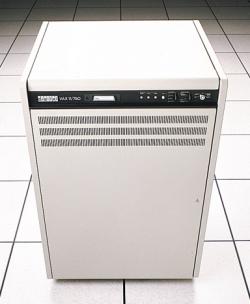 |
1980 |
 |
The first 32-bit LSI minicomputer
on the market, with a performance ratio of 0.6 VUP. A very reliable machine,
that can be found in computer collections. The development started just
a little later than that of the VAX-11/780, but the design team had difficulties
with the gate array technology used in the CPU. Despite that the
machine failed to deliver the expected performance, it was totally comaptible
with the original VAX: this was demonstrated with booting from the same
disk pack as a 11/780.
The system bus was called CMI (CPU-memory interconnect), expansion and I/O was accomplished via the Unibus (DW750 Unibus Adapter). The console was quite clever in contrast to the 11/780 (But this is just a personal remark! -Hamster), it consisted of a small module with an i8085 on it, and a TU58 console tape. The VAX-11/751 was a rackmounted version of the CPU, and rumour has it that there were some water-cooled 11/750's at MIT too! |
A look inside
...and another one
The front panel with the
TU58
The whole box
A 11/750 system with a TU80 magtape
drive
The same again, with a refrigurator
to the right corner
VAX-11/750+TU80+disks+DECwriter
II
Home-VAX: 11/750 with iron
and a washing machine
Sur-terraine 750
Misc
| VAX/VMS 2.0: The second release, with support
for the VAX-11/750, and lots of development tools and languages: FORTRAN,
Basic, Pascal, Cobol, PL/I, DSM, Coral66.
Ethernet: A new networking system developed at Xerox's Palo Alto Research Center (PARC). Digital introduced its line of ethernet-devices this year. DECnet phase III: DEC's own networking protocol, which allowed 200 nodes running 7 different operating systems, to be connected together. RM80: A Massbus disk, the first by Digital to incorporate winchester-technology. The whole device occupied a small rack, with the HDA (head and disk assembly) on top, and the electronics below. |

